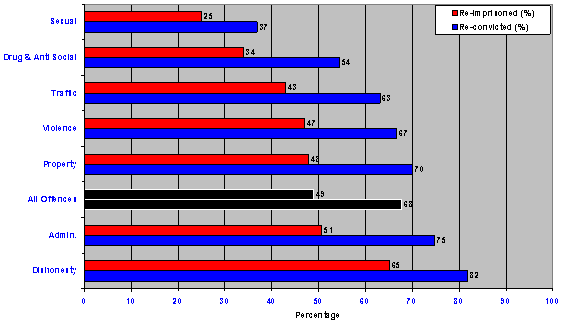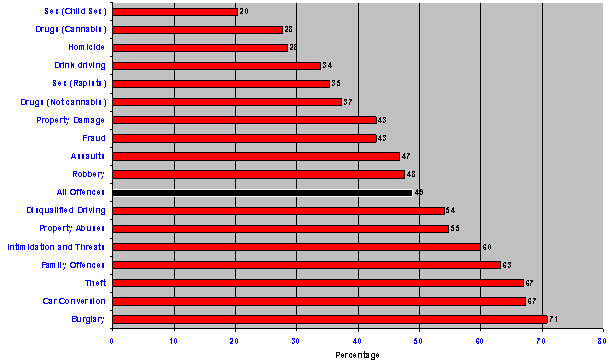Re-imprisonment rates by original offence type
The following two graphs show reconviction and re-imprisonment rates by the most serious offence for which the offender had previously been sentenced. These clearly reveal that re-imprisonment rates vary considerably between different types of offences: rates are highest among those who committed dishonesty offences (burglary, car conversion, theft, etc) and lowest among those who were convicted of sexual offences.
Graph 7: Reconviction/re-imprisonment rates by most serious offence class

Graph 8: Re-imprisonment rate by most serious offence type

A number of interesting observations can be made when sub-groups of offenders are examined in this way. The overall rate of re-imprisonment for sex offenders, at 20 percent, is relatively low, although the rate for rapists (35%) is considerably higher. This is likely to reflect the fact that rape offenders tend to be more generally orientated towards criminal offending (of all types), which is less so for child sex offenders, a proportion of whom have no convictions for other types of offences.
Each year a considerable number of offenders are sentenced to prison in New Zealand for either disqualified driving or drink-driving (these two offences make up 95% of all traffic offences resulting in imprisonment). While the overall rate of re-imprisonment for traffic offenders is 43 percent, a significant difference emerges between drink-drivers (34% reimprisonment rate) and disqualified drivers (54%). Many disqualified drivers are in fact persistent offenders with extensive criminal histories, of which disqualified driving is just one aspect. When such offenders are imprisoned for disqualified driving, they are typically also (concurrently) convicted of other offences, such as drink-driving, burglary, car conversion, theft or violence.
Most striking however are the very high rates of re-imprisonment amongst the dishonesty offenders - those convicted of theft, car conversion and burglary. These are of course crimes with very high base-rates (in the sense that they form the bulk of all recorded crime), which means that those who tend to engage in such crimes probably do so, relatively speaking, with high frequency. Family offences also notably have high rates of re-imprisonment.

